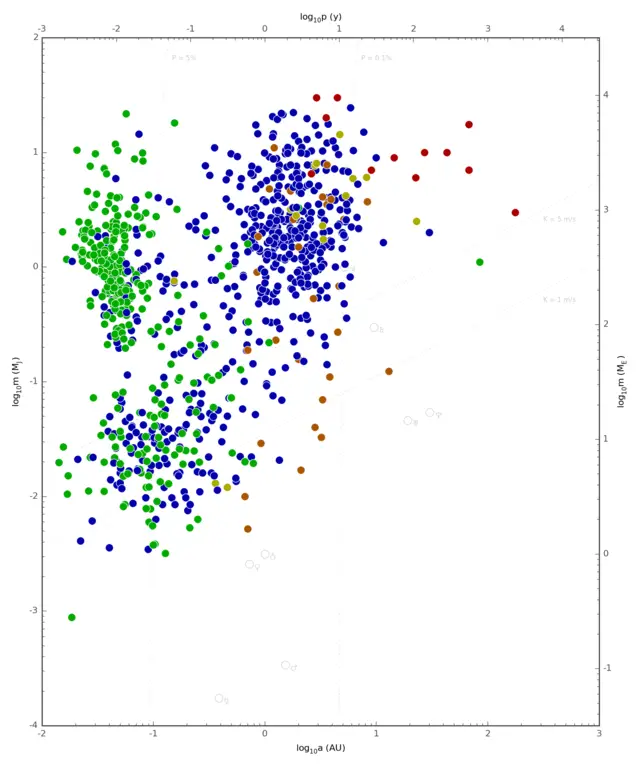
7th December 2014 How common is alien life in our galaxy? Using new data from Kepler, an astrobiologist has attempted to update the famous Drake equation. It is estimated that a biotic planet may be expected within 10-100 light years from Earth, while the nearest intelligent life is probably a few thousand light years away.
Amri Wandel is an astrobiologist at the Hebrew University of Jerusalem. His latest paper is available as a preprint version titled "On the abundance of extraterrestrial life after the Kepler mission" and will appear next year in the International Journal of Astrobiology. His research is based on the latest available data from Kepler, an exoplanet hunting telescope launched by NASA in 2009. To date, this observatory has revealed nearly 1,000 planets in 400 star systems, with a further 3,200 unconfirmed candidates. These range in size from small and Earthlike, to rocky "super Earths" with high gravity, to enormous "hot Jupiters" in close proximity to their parent star. While the sample size is tiny compared to the 100 billion+ total planets in our galaxy, it has nevertheless provided useful scientific data, allowing us to extrapolate some interesting estimates. Wandel has taken these figures and inputted them into the Drake Equation, to calculate the most realistic expectation of life elsewhere in our galaxy. The Drake Equation is a famous mathematical formula devised by the American Frank Drake in 1961. It uses several different variables to produce "N" – representing the number of intelligent civilisations with active radio communications in our galaxy.
R* = The rate of formation of stars suitable for the development of intelligent life. fp = The fraction of those stars with planetary systems. ne = The number of planets, per solar system, with an environment suitable for life. fl = The fraction of suitable planets on which life actually appears. fi = The fraction of life bearing planets on which intelligent life emerges. fc = The fraction of civilisations that develop a technology that releases detectable signs of their existence into space. L = The length of time such civilisations release detectable signals into space.
Until recently, there was little or no data to constrain the parameters in this formula. Now that Kepler and other telescopes are illuminating our region of the galaxy, astronomers are gaining at least some idea of how exoplanets are distributed in terms of size, mass, densities, orbits, composition and atmospheric characteristics. They are beginning, for the first time, to narrow the possible range of values in the Drake equation. For instance, it is now likely that a typical star has on average a minimum of one planet. Around 1 in 5 Sun-like stars have an "Earth-sized" planet within their habitable zone and the nearest of these is expected to be within 12 light years of Earth.
Using the latest available data, Wandel estimated the distribution of life-bearing worlds in our part of the universe. His calculation suggests there are likely to be millions or even billions of planets with simple life forms (i.e. resembling a single-celled amoeba) in the Milky Way, the closest being somewhere between 10-100 light years from Earth. Intelligent life is much rarer, the nearest such world likely to be a few thousand light years distant. That's assuming alien biology is at least somewhat predictable and similar to life here on Earth, of course – his estimate may be conservative. Silicon or ammonia-based life, for example, could use entirely different chemical structures unlike anything seen on our world. What may appear at first glance to be a "pebble" lying on the beach might, on closer inspection, turn out to be alive. Or there could be "living clouds" made of gaseous material. Michio Kaku, in his 2008 book Physics of the Impossible, offers his thoughts on the matter. The majority of alien creatures, according to him, would be limited in size by the laws of physics. After a certain point is reached, the ratio of size:mass becomes so unbalanced that an object soon collapses under its own weight. Assuming a biology at least somewhat similar to our own, organisms would be unlikely to grow much larger than dinosaurs. The largest ever dinosaur is thought to have been Amphicoelias fragillimus, a sauropod which may have grown to a length of 60 m (196 ft). As for advanced intelligence, futurist Ray Kurzweil says it is unlikely that a Star Trek-style universe exists. He divides the evolution of life into six epochs with exponential progress in the later stages. If his model is true, a civilisation with biological intelligence will transcend rapidly into post-biological form and reach "Singularity"-type status in a relatively short time. A scenario involving two biological intelligences meeting each other – like that between humans, Vulcans and other races – therefore seems improbable. There are still many uncertainties, with astrobiology and exoplanet science in their infancy, but progress is clearly accelerating now as shown by Wendel's study and others. Further refinements of the Drake equation will emerge in the near future, as exponentially growing data is pieced together by astronomers to form an increasingly accurate picture of the galaxy and our place within it. Future space telescopes will be far more powerful than Kepler – vastly increasing the tally of confirmed worlds and offering detailed analyses of exoplanets and their atmospheres. In fact, Kepler itself has already provided a hint of what lies ahead, having assisted in producing the first cloud map of an exoplanet last year. NASA is launching a mission called TESS in 2017, while ESA is deploying Cheops in the same year and PLATO from 2024-2030. New techniques used with ground-based telescopes should also help in characterising the many expected discoveries, possibly revealing biosignatures.
Comments »
|








